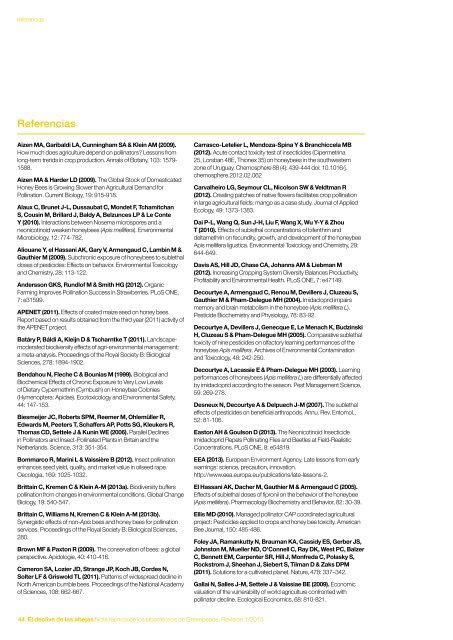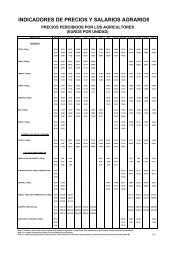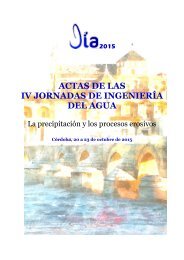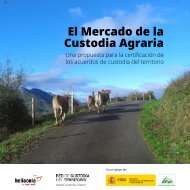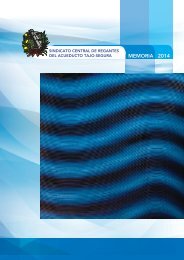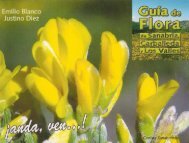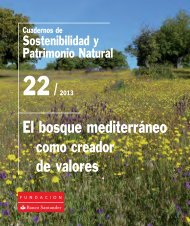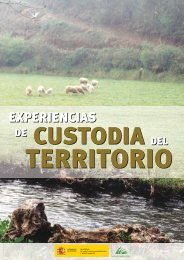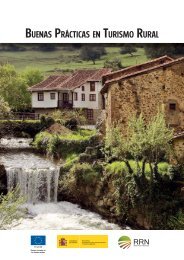GBpt1T
GBpt1T
GBpt1T
You also want an ePaper? Increase the reach of your titles
YUMPU automatically turns print PDFs into web optimized ePapers that Google loves.
eferenciasreferenciasReferenciasAizen MA, Garibaldi LA, Cunningham SA & Klein AM (2009).How much does agriculture depend on pollinators? Lessons fromlong-term trends in crop production. Annals of Botany, 103: 1579-1588.Aizen MA & Harder LD (2009). The Global Stock of DomesticatedHoney Bees is Growing Slower than Agricultural Demand forPollination. Current Biology, 19: 915-918.Alaux C, Brunet J-L, Dussaubat C, Mondet F, TchamitchanS, Cousin M, Brillard J, Baldy A, Belzunces LP & Le ConteY (2010). Interactions between Nosema microspores and aneonicotinoid weaken honeybees (Apis mellifera). EnvironmentalMicrobiology, 12: 774-782.Aliouane Y, el Hassani AK, Gary V, Armengaud C, Lambin M &Gauthier M (2009). Subchronic exposure of honeybees to sublethaldoses of pesticides: Effects on behavior. Environmental Toxicologyand Chemistry, 28: 113-122.Andersson GKS, Rundlof M & Smith HG (2012). OrganicFarming Improves Pollination Success in Strawberries. PLoS ONE,7: e31599.APENET (2011). Effects of coated maize seed on honey bees.Report based on results obtained from the third year (2011) activity ofthe APENET project.Batáry P, Báldi A, Kleijn D & Tscharntke T (2011). Landscapemoderatedbiodiversity effects of agri-environmental management:a meta-analysis. Proceedings of the Royal Society B: BiologicalSciences, 278: 1894-1902.Bendahou N, Fleche C & Bounias M (1999). Biological andBiochemical Effects of Chronic Exposure to Very Low Levelsof Dietary Cypermethrin (Cymbush) on Honeybee Colonies(Hymenoptera: Apidae). Ecotoxicology and Environmental Safety,44: 147-153.Biesmeijer JC, Roberts SPM, Reemer M, Ohlemüller R,Edwards M, Peeters T, Schaffers AP, Potts SG, Kleukers R,Thomas CD, Settele J & Kunin WE (2006). Parallel Declinesin Pollinators and Insect-Pollinated Plants in Britain and theNetherlands. Science, 313: 351-354.Bommarco R, Marini L & Vaissière B (2012). Insect pollinationenhances seed yield, quality, and market value in oilseed rape.Oecologia, 169: 1025-1032.Brittain C, Kremen C & Klein A-M (2013a). Biodiversity bufferspollination from changes in environmental conditions. Global ChangeBiology, 19: 540-547.Brittain C, Williams N, Kremen C & Klein A-M (2013b).Synergistic effects of non-Apis bees and honey bees for pollinationservices. Proceedings of the Royal Society B: Biological Sciences,280.Brown MF & Paxton R (2009). The conservation of bees: a globalperspective. Apidologie, 40: 410-416.Cameron SA, Lozier JD, Strange JP, Koch JB, Cordes N,Solter LF & Griswold TL (2011). Patterns of widespread decline inNorth American bumble bees. Proceedings of the National Academyof Sciences, 108: 662-667.Carrasco-Letelier L, Mendoza-Spina Y & Branchiccela MB(2012). Acute contact toxicity test of insecticides (Cipermetrina25, Lorsban 48E, Thionex 35) on honeybees in the southwesternzone of Uruguay. Chemosphere 88 (4): 439-444 doi: 10.1016/j.chemosphere.2012.02.062Carvalheiro LG, Seymour CL, Nicolson SW & Veldtman R(2012). Creating patches of native flowers facilitates crop pollinationin large agricultural fields: mango as a case study. Journal of AppliedEcology, 49: 1373-1383.Dai P-L, Wang Q, Sun J-H, Liu F, Wang X, Wu Y-Y & ZhouT (2010). Effects of sublethal concentrations of bifenthrin anddeltamethrin on fecundity, growth, and development of the honeybeeApis mellifera ligustica. Environmental Toxicology and Chemistry, 29:644-649.Davis AS, Hill JD, Chase CA, Johanns AM & Liebman M(2012). Increasing Cropping System Diversity Balances Productivity,Profitability and Environmental Health. PLoS ONE, 7: e47149.Decourtye A, Armengaud C, Renou M, Devillers J, Cluzeau S,Gauthier M & Pham-Delegue MH (2004). Imidacloprid impairsmemory and brain metabolism in the honeybee (Apis mellifera L).Pesticide Biochemistry and Physiology, 78: 83-92.Decourtye A, Devillers J, Genecque E, Le Menach K, BudzinskiH, Cluzeau S & Pham-Delegue MH (2005). Comparative sublethaltoxicity of nine pesticides on olfactory learning performances of thehoneybee Apis mellifera. Archives of Environmental Contaminationand Toxicology, 48: 242-250.Decourtye A, Lacassie E & Pham-Delegue MH (2003). Learningperformances of honeybees (Apis mellifera L) are differentially affectedby imidacloprid according to the season. Pest Management Science,59: 269-278.Desneux N, Decourtye A & Delpuech J-M (2007). The sublethaleffects of pesticides on beneficial arthropods. Annu. Rev. Entomol.,52: 81-106.Easton AH & Goulson D (2013). The Neonicotinoid InsecticideImidacloprid Repels Pollinating Flies and Beetles at Field-RealisticConcentrations. PLoS ONE, 8: e54819.EEA (2013). European Environment Agency. Late lessons from earlywarnings: science, precaution, innovation.http://www.eea.europa.eu/publications/late-lessons-2.El Hassani AK, Dacher M, Gauthier M & Armengaud C (2005).Effects of sublethal doses of fipronil on the behavior of the honeybee(Apis mellifera). Pharmacology Biochemistry and Behavior, 82: 30-39.Ellis MD (2010). Managed pollinator CAP coordinated agriculturalproject: Pesticides applied to crops and honey bee toxicity. AmericanBee Journal, 150: 485-486.Foley JA, Ramankutty N, Brauman KA, Cassidy ES, Gerber JS,Johnston M, Mueller ND, O’Connell C, Ray DK, West PC, BalzerC, Bennett EM, Carpenter SR, Hill J, Monfreda C, Polasky S,Rockstrom J, Sheehan J, Siebert S, Tilman D & Zaks DPM(2011). Solutions for a cultivated planet. Nature, 478: 337–342.Gallai N, Salles J-M, Settele J & Vaissiae BE (2009). Economicvaluation of the vulnerability of world agriculture confronted withpollinator decline. Ecological Economics, 68: 810-821.Garibaldi LA, Aizen MA, Klein AM, Cunningham SA & HarderLD (2011). Global growth and stability of agricultural yield decreasewith pollinator dependence. Proceedings of the National Academy ofSciences, 108: 5909-5914.Garibaldi LA, Steffan-Dewenter I, Winfree R, Aizen MA,Bommarco R, Cunningham SA, Kremen C, CarvalheiroLsG, Harder LD, Afik O, Bartomeus I, Benjamin F, BoreuxV, Cariveau D, Chacoff NP, Dudenhöffer JH, Freitas BM,Ghazoul J, Greenleaf S, Hipólito J, Holzschuh A, Howlett B,Isaacs R, Javorek SK, Kennedy CM, Krewenka K, KrishnanS, Mandelik Y, Mayfield MM, Motzke I, Munyuli T, Nault BA,Otieno M, Petersen J, Pisanty G, Potts SG, Rader R, RickettsTH, Rundlof M, Seymour CL, Schüepp C, Szentgyörgyi H, TakiH, Tscharntke T, Vergara CH, Viana BF, Wanger TC, WestphalC, Williams N & Klein AM (2013). Wild Pollinators Enhance Fruit Setof Crops Regardless of Honey Bee Abundance. Science, PublishedOnline February 28 2013.Genersch E, von der Ohe W, Kaatz H, Schroeder A, Otten C,Bachler R, Berg S, Ritter W, Mohlen W, Gisder S, Meixner M,Liebig G & Rosenkranz P (2010). The German bee monitoringproject: a long term study to understand periodically high winterlosses of honey bee colonies*. Apidologie, 41: 332-352.Gill RJ, Ramos-Rodriguez O & Raine, NE (2012). Combinedpesticide exposure severely affects individual –and colony-level traitsin bees. Nature 491: 105-108 doi:10.1038/nature11585Girolami V, Mazzon L, Squartini A, Mori N, Marzaro M,Bernardo AD, Greatti M, Giorio C & Tapparo A (2009).Translocation of Neonicotinoid Insecticides from Coated Seeds toSeedling Guttation Drops: A Novel Way of Intoxication for Bees.Journal of Economic Entomology, 102: 1808-1815.Greenleaf SS & Kremen C (2006). Wild bee species increasetomato production and respond differently to surrounding land use inNorthern California. Biological Conservation, 133: 81-87.Hatjina F, Papaefthimiou C, Charistos L, Dogaroglu T,Bouga M, Emmanouil C & Arnold G (2013). Sublethal dosesof imidacloprid decreased size of hypopharyngeal glands andrespiratory rhythm of honeybees in vivo. Apidologie DOI: 10.1007/s13592-013-0199-4Henry Ml, Beguin M, Requier F, Rollin O, Odoux J-F, AupinelP, Aptel J, Tchamitchian S & Decourtye A (2012). A CommonPesticide Decreases Foraging Success and Survival in Honey Bees.Science 1215039 Published online 29 March 2012 [DOI:10.1126/science.1215039].Higes M, Meana A, Bartolomé C, Botías C & Martín-HernándezR (2013). Nosema ceranae (Microsporidia), a controversial 21stcentury honey bee pathogen. Environmental Microbiology Reports,5: 17-29.Holzschuh A, Dudenhöffer J-H & Tscharntke T (2012).Landscapes with wild bee habitats enhance pollination, fruit set andyield of sweet cherry. Biological Conservation, 153: 101-107.Holzschuh A, Steffan-Dewenter I & Tscharntke T (2008).Agricultural landscapes with organic crops support higher pollinatordiversity. Oikos, 117: 354-361.IAASTD (2009). International Assessment of Agricultural Science andTechnology for Development. Island Press.http://www.agassessment.org.Jeschke P, Nauen R, Schindler M & Elbert A (2010). Overviewof the Status and Global Strategy for Neonicotinoids. Journal ofAgricultural and Food Chemistry, 59: 2897-2908.Jha S & Kremen C (2013). Resource diversity and landscape-levelhomogeneity drive native bee foraging. Proceedings of the NationalAcademy of Sciences, 110: 555-558.Kremen C & Miles A (2012). Ecosystem Services in BiologicallyDiversified versus Conventional Farming Systems: Benefits,Externalities, and Trade-Offs. Ecology and Society, 17.Kremen C, Williams NM, Aizen MA, Gemmill-Herren B,LeBuhn G, Minckley R, Packer L, Potts SG, Roulston Ta,Steffan-Dewenter I, Vazquez DP, Winfree R, Adams L, CroneEE, Greenleaf SS, Keitt TH, Klein A-M, Regetz J & RickettsTH (2007). Pollination and other ecosystem services produced bymobile organisms: a conceptual framework for the effects of land-usechange. Ecology Letters, 10: 299-314.Lambin M, Armengaud C, Raymond S & Gauthier M (2001).Imidacloprid-induced facilitation of the proboscis extension reflexhabituation in the honeybee. Archives of Insect Biochemistry andPhysiology, 48: 129-134.Lautenbach S, Seppelt R, Liebscher J & Dormann CF (2012).Spatial and Temporal Trends of Global Pollination Benefit. PLoS ONE,7: e35954.Lebuhn G, Droege S, Connor EF, Gemmill-Herren B, Potts SG,Minckley RL, Griswold T, Jean R, Kula E, Roubik DW, Cane J,Wright KW, Frankie G & Parker F (2013). Detecting Insect PollinatorDeclines on Regional and Global Scales. Conservation Biology, 27:113-120.Medrzycki P, Montanari R, Bortolotti L, Sabatini AG, MainiS & Porrini C (2003). Effects of imidacloprid administered in sublethaldoses on honey bee behaviour. Laboratory tests. Bulletin ofInsectology, 56: 59-62.Memmott J, Craze PG, Waser NM & Price MV (2007). Globalwarming and the disruption of plant–pollinator interactions. EcologyLetters, 10: 710-717.Morandin LA & Winston ML (2005). Wild Bee Abundance and SeedProduction in Conventional, Organic, and Genetically Modified Canola.Ecological Applications, 15: 871-881.Morandin LA & Winston ML (2006). Pollinators provide economicincentive to preserve natural land in agroecosystems. Agriculture,Ecosystems & Environment, 116: 289-292.Mullin CA, Frazier M, Frazier JL, Ashcraft S, Simonds R &Pettis JS (2010). High levels of miticides and agrochemicals in NorthAmerican apiaries: implications for honey bee health. PLoS ONE, 5:e9754.Nørgaard KB & Cedergreen N (2010). Pesticide cocktails caninteract synergistically on aquatic crustaceans. Environmental Scienceand Pollution Research, 17: 957-967.44 El declive de las abejas Nota técnica de los laboratorios de Greenpeace. Revisión 1/2013El declive de las abejas Nota técnica de los laboratorios de Greenpeace. Revisión 1/2013 45


